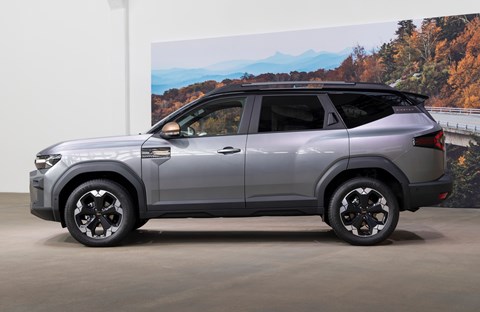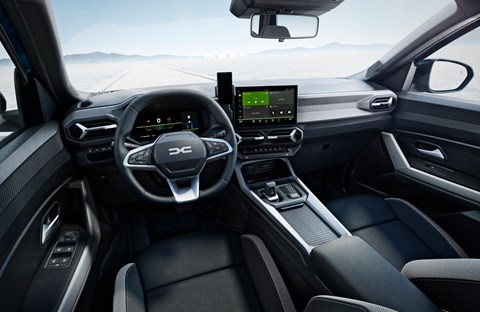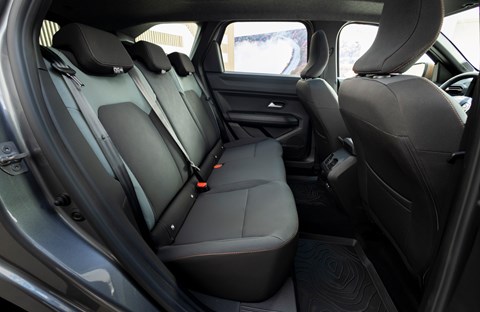► All-new Dacia Bigster SUV priced from £24,995
► Petrol and hybrid power and ‘real’ 4×4 version; massive boot
► Luxuries new to Dacia like an electric tailgate and two-tone paint
Dacia’s new Bigster SUV has finally arrived. The covers came off at the 2024 Paris motor show and Dacia has just announced a sucker punch: the new Bigster will be priced from £24,995.
The large family SUV is 4.57 metres long, so will naturally be going up against cars like the oh-so-popular Ford Kuga, Hyundai Tucson and VW Tiguan, as well as the five-seat Skoda Kodiaq.

‘Obviously there is so much competition, but Dacia does things a bit differently,’ smiles Patrice Levy-Bencheton, Dacia’s VP for product performance. ‘We still believe there’s room for a value proposition here, and we want to systematically have the best value-for-money offer in the market. Our goal with Bigster is to do exactly that again – it’s the natural Dacia way.’

This is Dacia’s first entrant into the ‘C-segment’ of the car market – one of the most, if not *the* most competitive part of the car market in Europe. The brand has big plans over the next few years to venture further into this part of the market, with brand boss Denis Le Vot telling CAR that the brand will offer two more new C-segment models, but will ‘be more imaginative’ than just selling two more SUVs.
Anyway, the Bigster is a big deal, promising to shake up the family SUV market with its big space and big value offer. Want to know more? We’ve been given one-on-one access to the Bigster and the brains behind it.
It… looks like a Duster

Well, duh. The clue’s in the name – it’s almost designed to be a bigger Duster – and we’ve all sort of known what the car was going to look like after we saw the concept version in 2021. Still though, this is a bold looking thing – quite possibly the boldest a Dacia has ever looked. ‘We’re making something that’s meant to be robust and last the test of time here,’ says design director, David Durand. ‘We’re not making a hugely dynamic or aggressive car, it’s a question of balance.’
But there are a few key differences with Bigster. The biggest visual differences are the wheelbase and that bulky rear end; the former is proof of Dacia’s efforts to stretch the Renault Group CMF-B platform to its absolute limit, while the latter is designed to maximise rear headroom and boot space.

There are some new details never seen on a Dacia before. New 19-inch wheels are available on the top trips and check out the two-tone paint – a black roof coupled with a new Indigo Blue colour is a first for the brand. Think of it as something a little more mature to go with bolder terracotta oranges and khaki greens.
And the two-tone black roof is literally printed onto the car, speeding up the usual process of painting two-tone colours. ‘It’s this new technology we’re introducing that, yes, is a lot like an ink printer,’ says Levy-Bencheton. ‘You can be so precise with the pigmentations of the paint with this robot we’re using, and it ends up being more than half the cost of the old way.’

‘It also means just one round of paint protection coating, so you end up with around the same energy consumption as applying a single paint colour,’ adds Durand. ‘It opens up so many possibilities for us.’
What’s it like inside?

The Bigster’s interior naturally features plenty of details seen in other Dacia and Renault Group models. It’s clean and neat inside, with a large, thick-rimmed steering wheel and a few new design elements exclusive to the Bigster. The most obvious is a rather high centre console, offering a very different kind of interior vibe to the smaller Duster. ‘This high centre console one of the main calling cards of something in the C-segment,’ says interior design chief, Magali Gouraud. ‘It’s so much more ergonomic this way and gives you plenty of bonus interior storage you wouldn’t get otherwise.’

As well as the same size infotainment screen seen on both the Spring EV and new Duster, the Bigster benefits from the brand’s YouClip mounting points that launched with the new Duster, offering accessories that allow you to ‘bring a bit of your own life into the car,’ says Gouraud (pictured above). Points are located on the dashboard and on the inside of the tailgate, and one is located at the end of the centre console for the rear passengers to use. Plenty of other accessories can be bought, too, including useful storage solutions for those in the rear.
The Bigster will be available in Dacia’s traditional trim variants, starting with Essential, rising through Expression to Journey (pictured in blue) and Extreme (pictured in grey) – the two top trims that offer either loads of equipment or focus on being prepared for anything. New firsts inside include electric seats and a powered tailgate. Upper variants will also benefit from a Neoprene-like seat upholstery trimmed with a breathable lightweight fabric inspired by Adidas’ Primeknit and Nike’s Flyknit.

Given this thing’s bigger than a Duster, there’s a much larger second row – my 6’2” self has sat in the back behind my driving position and there’s loads of space. Dacia also offers 40/20/40 split-folding rear seats on most versions. ‘We should also have the best boot space volume in the C-SUV market,’ says Bigster program lead, Ludovic Dupont, with the 600 litres of space (from floor to parcel shelf) being a little more than Citroen’s C5 Aircross and way more than any other car this size bar the Kodiaq.

Neat details add to the car’s usability, too – there are moulds in the central rear seat that, when folded down, offer cupholders and device holders. The adjustable boot floor has a second use as a luggage divider. Roof racks are neatly integrated into the rails, meaning you don’t have to buy a set to fit and, like the Jogger and Duster, the Bigster will benefit from Dacia’s Sleep Pack fold-out bed and tent.
It is, however, only a five-seater. Durand says if the team had made it able to seat seven, it would have compromised weight as well as the car’s design and aerodynamics – something the team weren’t prepared to do, particularly given it has the Jogger in the range.
What engine options are there?

Three are offered. The base version uses a mild hybrid three-cylinder petrol engine, two-wheel drive and a manual gearbox. That can be upgraded to an auto with four-wheel drive. ‘And that’s a real 4×4!’ smiles Levy-Bencheton as he takes subtle pot shots at the Citroen C5 Aircross. ‘We’re not talking about some ‘extended grip’ function like on some other C-segment SUVs.’
The real newbie, though, is the Bigster Hybrid. It, again, uses Renault E-Tech Hybrid technology, but this time deploys the more powerful 153bhp model in a Dacia for the first time. Dacia is also continuing to offer its LPG-infused BiFuel variant in markets that’ll accept it.
Come on then, how much?

Dacia has finally announced pricing for the Bigster, and it’s even beaten our predictions. The new five-seat family SUV will be priced from £24,995 in the UK for a basic TCe 140 Expression model. Your cheapest hybrid model will start at £27,995.
If you want plusher Journey trim, prices start at £26,245 and for Extreme trim, you’ll need at least £26,495. Interestingly, the most you can spend on a Bigster right out of the box is under £30k.
All of these numbers mean the Bigster is tied for being the cheapest car in its class alongside the latest MG HS, undercutting the likes of the Citroen C5 Aircross and Skoda Kodiaq.